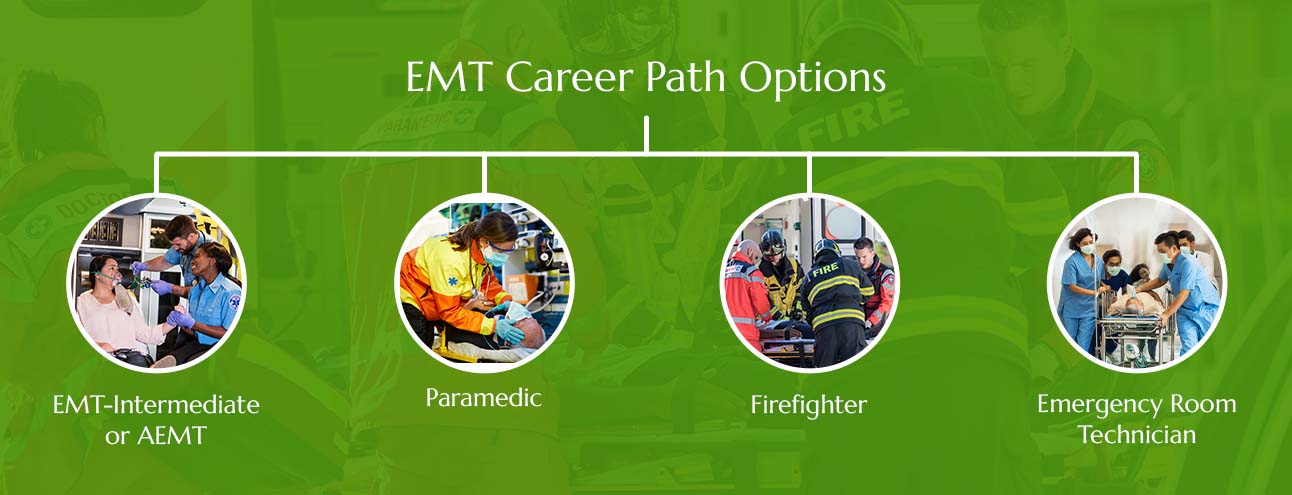Are you an emergency medical technician (EMT) looking to further your career or an aspiring EMT seeking out the right career path? Getting your EMT-Basic certification is the first step. From there, there are various paths you can consider, from EMT-Intermediate to firefighter to paramedic.
How do you move up as an EMT? What can being an EMT lead to? Explore some of the opportunities for EMT career development below.
Option 1: EMT-Intermediate or AEMT
EMT-Intermediate or advanced EMT (AEMT) is the second EMT training level. These individuals have fulfilled the requirements for the EMT-Basic level, as well as coursework regarding more advanced medical practices and procedures.
Like EMT-Basics, EMT-Intermediates provide basic emergency treatment for trauma, respiratory and cardiac emergencies, as well as obstructed airways. However, EMT-Intermediates have more clinical experience. You’ll be trained to administer intravenous (IV) fluids and a wide range of medications, unlike your EMT-Basic colleagues.
To become an EMT-Intermediate, you’ll need to complete a state-approved training program. This can range from a few months to a year. Training programs in this field extend far beyond traditional classroom lectures, usually including practical skill labs and laboratory simulations.
You’ll also perform supervised clinical procedures at a hospital, as well as in a pre-hospital care environment. You’ll dive into advanced topics and skills like airway techniques, patient assessment and life support. In addition, you’ll learn how to administer IVs and medications used to treat conditions such as shock and diabetic emergencies.
It’s also worth noting that there is a positive job outlook for EMTs and paramedics, with overall employment projected to grow 7% from 2021 to 2031. If you’re looking to pursue your EMT-Intermediate certification, you can register for PERCOMOnline’s AEMT training program.
Option 2: Paramedic
EMTs and paramedics both save lives, work similar shifts and spend their days inside an ambulance or at an EMT headquarters. Even the uniforms they wear are similar. However, EMTs and paramedics differ in responsibilities, training and salary.
As first responders, EMTs and paramedics provide timely aid to those suffering from illnesses or injuries. However, EMTs aren’t permitted to break the skin of their patients. This means no IVs or needles — the only exceptions are auto-injectors, like EpiPens.
A paramedic participates in EMT training, like starting IVs, administering medications and airway management as a foundation for more advanced techniques. These include administering shots, drawing blood and providing advanced cardiac life support. With these additional skills and training, a paramedic can save a life in a complicated event where basic or intermediate EMT training may not be sufficient.
Consider salary if you are deciding whether to become a paramedic. The average paramedic salary is $46,241 in the U.S., while the average EMT salary is $35,940.
In Texas, becoming a paramedic requires between 1,300 and 1,800 hours of training before obtaining your certification. Paramedic programs typically require an EMT-Basic certification minimum before you can begin training. You’ll also need to pass the National Registry of Emergency Medical Technicians Exam (NREMT), as well as the National Registry Paramedic (NRP) cognitive exam.
If you’re interested in becoming a paramedic, PERCOMOnline has Texas-based paramedic training courses to assist you.

Option 3: Firefighter
In most cases, firefighters are required to have basic EMT certification. Firefighters are sometimes the first to arrive at an emergency scene. Having that EMS training can help them tend to victims in fires or accidents. There are also some medical specialist firefighters who care for victims after they’ve been rescued from a fire.
Some fire departments require applicants to have EMT certification — or even NREMT paramedic certification, in some cases — before hiring them as firefighters. Even in areas where EMT or paramedic certification isn’t required, having this training can give you a competitive advantage over other applicants — and potentially a higher salary.
While having EMT-Basic certification is a valuable asset for getting hired as a firefighter, you’ll also need additional training for firefighter-specific duties. Being a firefighter is a physically demanding job, which is why fire departments typically administer physical ability tests to ensure candidates can adequately perform their job responsibilities.
You’ll undergo rigorous physical examinations both in and before entering the academy. Upper body strength is crucial, as you’ll be lifting people and heavy objects to rescue them in emergency situations. You’ll also need the endurance necessary to handle frequent running around. Some exercises during your physical training might include:
- Ladder raises
- Hose hoists
- Stair climbs
- Running
- Simulated victim rescues
- Equipment carries
You’ll also need to pass a written exam to demonstrate your firefighting knowledge. These tests can vary by location, so it might help to call your local department to get information about the type of test you’ll be taking. That way, you can adequately prepare.
Firefighter employment is expected to increase 4% from 2021 to 2031, with an average of 28,000 job openings projected annually over the decade.
Option 4: Emergency Room Technician
Emergency room technicians (ERTs) assist nurses with basic clinical and administrative tasks for incoming patients. They’re generally responsible for ensuring patients are fed, clean and well cared for. Following the directives of ER doctors and nurses, they often perform tasks like:
- Monitoring blood pressure
- Fitting patients for casts and crutches
- Collecting blood, urine, stool and other samples from patients
- Dressing wounds
- Starting IV lines
- Transporting patients
- Handing nurses and doctors medical supplies during procedures
An ERT is essentially the same role as an EMT, except the patient comes to you instead of you going to them. That means if you have your EMT certification, you’re nearly qualified to start working as an ERT.
You’ll need to be proficient in the skills gained during your EMT training. Additionally, some hospitals may require ERT certification programs, where you’ll study practices like emergency childbirth, phlebotomy, administering diagnostic tests and the other ERT tasks mentioned above.
Advance Your EMT Career With PERCOMOnline
Are you looking to climb the EMT career ladder? With various EMT career progression opportunities available at PERCOMOnline, we can help pave the way to your success. Our program provides NREMT certification for Texas residents so they can receive the additional EMT training needed to pursue their desired patient care jobs and volunteer positions, making a valuable difference in their community.
Our courses are offered online, with clinical rotations and skills training administered in person. Additionally, non-Texas residents can also attend and earn a license in their own state via reciprocity.
Explore career advancement for EMTs at PERCOMOnline. Browse our training courses to discover the right EMT career path for you.
